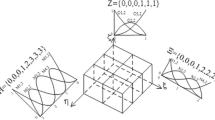Abstract
In isogeometric analysis, it is frequently required to handle the geometric models enclosed by four-sided or non-four-sided boundary patches, such as trimmed surfaces. In this paper, we develop a Gregory solid based method to parameterize those models. First, we extend the Gregory patch representation to the trivariate Gregory solid representation. Second, the trivariate Gregory solid representation is employed to interpolate the boundary patches of a geometric model, thus generating the polyhedral volume parametrization. To improve the regularity of the polyhedral volume parametrization, we formulate the construction of the trivariate Gregory solid as a sparse optimization problem, where the optimization objective function is a linear combination of some terms, including a sparse term aiming to reduce the negative Jacobian area of the Gregory solid. Then, the alternating direction method of multipliers (ADMM) is used to solve the sparse optimization problem. Lots of experimental examples illustrated in this paper demonstrate the effectiveness and efficiency of the developed method.
Similar content being viewed by others

References
T J R Hughes, J A Cottrell, Y Bazilevs. Isogeometric analysis: CAD, finite elements, NURBS, exact geometry and mesh refinement, Computer Methods in Applied Mechanics & Engineering, 2005, 194(39): 4135–4195.
P M Knupp. Achieving finite element mesh quality via optimization of the Jacobian matrix norm and associated quantities, Part II-A framework for volume mesh optimization and the condition number of the Jacobian matrix, International Journal for Numerical Methods in Engineering, 2000, 48(8): 1165–1185.
S Boyd, N Parikh, E Chu, B Peleato, J Eckstein. Distributed optimization and statistical learning via the alternating direction method of multipliers, Foundations & Trends in Machine Learning, 2010, 3(1): 1–122.
M S Floater. Parametrization and smooth approximation of surface triangulations, Computer Aided Geometric Design, 1997, 14(3): 231–250.
P V Sander, J Snyder, S J Gortler, H Hoppe. Texture mapping progressive meshes, In SIGGRAPH 2001 Conf. Proc, 2001, 14(3): 409–416.
P Alliez, G Ucelli, C Gotsman, M Attene. Recent advances in remeshing of surfaces, Shape Analysis and Structuring, 2008.
K Hormann, G Greiner. Mips: An efficient global parametrization method, Curve and Surface Design: Saint-Malo, 1999, 153–162.
P Degener, J Meseth, R Klein. Texture mapping progressive meshes, International Meshing Roundtable, 2003, (7): 201–213.
M S Floater, K Hormann. Surface Parameterization: a Tutorial and Survey, Advances in Multiresolution for Geometric Modelling, 2005, 1: 157–186.
A Sheffer, E Praun, K Rose. Mesh parameterization methods and their applications, Foundations & Trends in Computer Graphics & Vision, 2006, 2(2): 105–171.
T Martin, E Cohen, R M Kirby. Volumetric parameterization and trivariate b-spline fitting using harmonic functions, Computer Aided Geometric Design, 2009, 26(6): 648–664.
T Martin, E Cohen. Volumetric parameterization of complex objects by respecting multiple materials, Computer & Graphics, 2010, 34(3): 187–197.
H Lin, S Jin, Q Hu, Z Liu. Constructing b-spline solids from tetrahedral meshes for isogeometric analysis, Computer Aided Geometric Design, 2015, 35–36: 109–120.
W Wang, Y Zhang, L Liu, T J R Hughes. Trivariate solid t-spline construction from boundary triangulations with arbitrary genus topology, Computer-Aided Design, 2013, 45(2): 351–360.
G Xu, B Mourrain, R Duvigneau, A Galligo. Analysis-suitable volume parameterization of multi-block computational domain in isogeometric applications, Computer-Aided Design, 2013, 45(2): 395–404.
Y Zhang, W Wang, T J R Hughes. Conformal solid T-spline construction from boundary T-spline representations, Computational Mechanics, 2013, 51(6): 1051–1059.
X Wang, X Qian. An optimization approach for constructing trivariate B-spline solids, Computer-Aided Design, 2014, 46(1): 179–191.
H Lin, H Huang, C Hu. Trivariate b-spline solid construction by pillow operation and geometric iterative fitting, SCIENCE CHINA Information Sciences, 2018, 61(11): 118103.
M Meyer, A Barr, H Lee, M Desbrun. Generalized barycentric coordinates on irregular polygons, Journal of Graphics Tools, 2002, 7(1): 13–22.
M S Floater. Mean value coordinates, Computer Aided Geometric Design, 2003, 20(1): 19–27.
M S Floater, G Kós, M Reimers. Mean value coordinates, Computer Aided Geometric Design, 2005, 22(7): 623–631.
P Joshi, M Meyer, T Derose, B Green, T Sanocki. Harmonic coordinates for character articulation, Transactions on Graphics, 2007, 26(3): 71.
Y Lipman, D Levin, D Cohen-Or. Green coordinates, Transactions on Graphics, 2008, 27(3): 1–10.
H Chiyokura, F Kimura. Design of solids with free-form surfaces, ACM SIGGRAPH Computer Graphics, 1983, 17(3): 289–298.
H Chiyokura. Localized surface interpolation method for irregular meshes, Advanced Computer Graphics, 1986, 3–19.
J A Gregory. Smooth interpolation without twist constraints, Computer Aided Geometric Design, 1974, 71–87.
L Longhi. Interpolating patches between cubic boundaries, Computer Science Division, 1987.
C C L Wang, K Tang. Non-self-overlapping structured grid generation on an n-sided surface, International Journal for Numerical Methods in Fluids, 2004, 46(9): 961–982.
M Avriel. Nonlinear Programming: Analysis and Methods, 1976.
Author information
Authors and Affiliations
Corresponding author
Additional information
This paper was supported by the National Natural Science Foundation of China (No. 61872316), the National Key R&D Program of China (No. 2016YFB1001501), and the Fundamental Research Funds for the Central Universities(No. 2017XZZX009-03).
Rights and permissions
About this article
Cite this article
Hu, Cf., Lin, Hw. Gregory Solid Construction for Polyhedral Volume Parameterization by Sparse Optimization. Appl. Math. J. Chin. Univ. 34, 340–355 (2019). https://doi.org/10.1007/s11766-019-3697-y
Received:
Revised:
Published:
Issue Date:
DOI: https://doi.org/10.1007/s11766-019-3697-y



